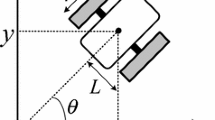Abstract
In this paper, an interpolation-based path planning algorithm is employed for generating smooth paths on uniform resolution grid-maps. First, it starts at the goal node and propagates through four neighboring nodes, assigning monotonically increasing values to nodes using FMM (Fast Marching Method) interpolation. Consequently, we obtain a goal-propagation map that is zero-cost at the goal node and monotonically increasing along the wavefront propagation from the goal node. Subsequently, it begins from the robot’s position and uses a linear interpolation approach to generate nearoptimal paths. After obtaining the planned path, an improved path following algorithm based on an improved virtual vehicle method is employed to follow the path considering the robot’s dynamic and kinematic constraints. The experimental results demonstrate the performance of our approach.
Similar content being viewed by others
References
S. Koenig and M. Likhachev, “D* lite,” Proc. of the National Conference on Artificial Intelligence (AAAI), Alberta, Canada, pp. 476–483, 2002.
H. Carlos, M. Pedro, X. Sun, and K. Sven, “Pathadaptive A* for incremental heuristic search in unknown terrain,” Proc. of the 19th International Conference on Automated Planning and Scheduling, pp. 358–361, 2009.
M. Likhachev, D. Ferguson, G. Gordon, A. Stentz, and S. Thrun, “Anytime dynamic A*: an anytime, replanning algorithm,” Proc. of the International Conference on Automated Planning and Scheduling (ICAPS), California, USA, pp. 262–271, 2005.
R. Philippsen, B. Jesnen, and R. Siegwart, “Toward online probabilistic path replanning in dynamic environments,” Proc. of IEEE/RSJ International Conference on Intelligent Robots and Systems, pp. 2876–2881, 2006.
V. Mallet, “Modeling wildland fire propagation with level set methods,” Computers and Mathematics with Applications, vol. 57, no. 7, pp. 1089–1101, 2009.
W. Yossawee, T. Tsubouchi, M. Kurisu, and S. Sarata, “A semi-optimal path generation scheme for a frame articulated steering-type vehicle,” Advanced Robotics, vol. 20, no. 9, pp. 867–896, 2006.
K. Nagatani, Y. Iwai, and Y. Tanaka, “Sensor-based navigation for car-like mobile robots based on a generalized Voronoi graph,” Advanced Robotics, vol. 17, no. 5, pp. 385–402, 2007.
C. Jonathan, “An RRT-based path planner for use in trajectory imitation,” Proc. of IEEE International Conference on Robotics and Automation, pp. 3090–3095, 2010.
Z. Liang, X. Ma, and X. Dai. “A novel path planning algorithm based on twofold interpolations,” Proc. of IEEE Int. Conf. on Mechatronics and Automation (ICMA), Takamatsu, Kagawa, Japan, pp. 718–723, 2008.
J. Andrews and J. A. Sethian, “Fast marching methods for the continuous traveling salesman problems,” Proceedings National Academy Sciences, pp. 1118–1123, 2007.
R. Kimmel and J. A. Sethian, “Computing geodesic paths on manifolds,” Proceedings National Academy Sciences, pp. 8431–8435, 1998.
B. Tijmen, V. Kees, B. Jan, and M. Joachim, “A path following algorithm for mobile robots,” Autonomous Robots, vol. 29, no. 2, pp. 85–97, 2010.
R. Gilimyanov, A. Pesterev, and L. Rapoport, “Motion control for a wheeled robot following a curvilinear path,” Journal of Computer and Systems Sciences International, vol. 47, no. 6, pp. 987–994, 2008.
K. Macek, I. Petrovic, and R. Siegwart, “A control method for stable and smooth path following of mobile robots,” Proc. of the European Conference on Mobile Robots (ECMR), Ancona, Italy, pp. 128–123, 2005.
M. A. Sotelo, “Lateral control strategy for autonomous steering of Ackerman-like vehicles,” Robotics and Autonomous Systems, vol. 45, no. 9, pp. 223–233, 2003.
Author information
Authors and Affiliations
Corresponding author
Additional information
Recommended by Editorial Board member Sooyeong Yi under the direction of Editor-in-Chief Jae-Bok Song.
This paper was supported by the Open Foundation of Key Laboratory of Measurement and Control of Complex Systems of Engineering, Ministry of Education (No.2010A003), the Natural Science Foundation of China (No.61104216 and 60805032), the Jiangsu Province Science Foundation (No.10KJB510014 and BK2011758) and NTFC Program (No. 20103223120003).
Zhiwei Liang received his Ph.D. degree in School of Automation from Southeast University in 2009. He is currently a teacher of College of Automation at Nanjing University of Posts and Telecommunications. His main research interests include image processing, mobile robot localization and navigation and multi-sensor information fusion.
Songhao Zhu received his Ph.D. degree from Shanghai Jiao Tong University, from the Institute of Image Processing and Pattern Recognition. He received his M.S. degree in Electrical Engineering from Nanjing University of Aeronautics and Astronautics. In September 2009, he jointed Nanjing University of Posts and Telecommunications. His research interests include multimedia communication, image processing pattern recognition, and computer vision.
Fang Fang received her Ph.D. degree from School of Automation at Southeast University. She is currently a teacher of School of Automation at Southeast University. Her main research interests include mobile robot localization and navigation, motion pattern analysis and multi-sensor information fusion.
Rights and permissions
About this article
Cite this article
Liang, Z., Zhu, S. & Fang, F. A twofold-interpolation-based path planning algorithm and its path following based on improved virtual vehicle method. Int. J. Control Autom. Syst. 10, 186–191 (2012). https://doi.org/10.1007/s12555-012-0122-1
Received:
Revised:
Accepted:
Published:
Issue Date:
DOI: https://doi.org/10.1007/s12555-012-0122-1




